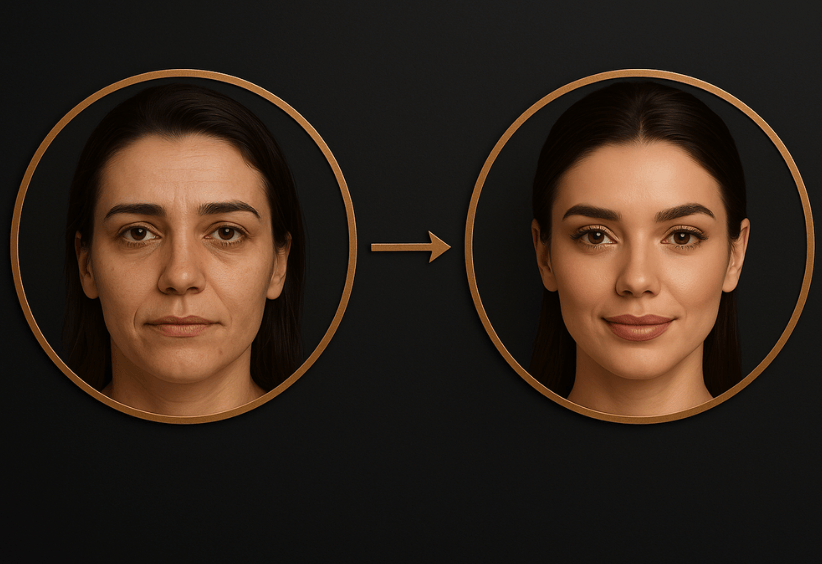New generation plastic surgery techniques are bringing revolutionary changes to facial rejuvenation. Endoscopic temporal-facelift is one of these methods that stands out. This procedure addresses the sagging problem in the upper region in younger individuals (20s-30s), while targeting the aging signs that appear in the upper face (temples, forehead, around the eyebrows) in older age groups. With its natural results and fast recovery process, this method is effective as a temporal lift in younger patients, while it should be combined with other facelift techniques in older individuals.
What Is Endoscopic Temporal-Facial Lift?
The endoscopic temporal-facial lift is a minimally invasive surgical procedure performed using a small camera called an endoscope and specialized surgical tools through a small incision. By accessing the temple-forehead area through small incisions of about 3 cm in the scalp, the risk of visible scarring is minimized and more precise intervention to the tissues is possible.

- Correct sagging and hollowness in the upper and mid-face
- Lift drooping eyebrows
- Create a younger and more defined contour in the upper face
- Reduce deep wrinkles and achieve a natural expression
This technique targets drooping in the upper and mid-face in younger patients, while in older patients, it aims to reposition tissues for a facial lifting effect.
Who Is It Suitable For?
Individuals aged 20-40:
Patients with sagging or drooping in the upper and mid-face. These individuals often have a downward eye vector and prominent sclera (white of the eye). Brow ptosis is commonly present. Lifting both the upper and mid-face areas provides a more balanced and effective outcome.
Individuals aged 40-70:
Patients with significant sagging or volume loss in the upper face, resulting from gravity and aging. These signs include brow ptosis and hollow temples, leading to a tired and aged appearance. In this age group, combining this method with other facial lifting techniques (e.g., deep plane facelift) yields better results.
How Is It Done? Step-by-Step Process
Planning:
Facial analysis is performed, and incision points are determined. Surgical techniques vary depending on the degree of eye pull, making preoperative consultation essential.
Anesthesia:
The procedure is performed under general anesthesia.
Incisions:
Two incisions of about 3 cm are made in the hair-bearing scalp at the temples. If a forehead lift is also planned, two additional 2 cm incisions are made in the scalp of the forehead area.
Tissue Manipulation:
The procedure is performed under the deep temporal fascia and periosteum. Ligaments causing sagging are released, allowing the entire face to be lifted upward through the temporal fascia. For patients who desire more almond-shaped eyes, the periosteum around the eye can also be released. Preoperative planning is essential due to these variations.
Closure:
Incisions are closed with absorbable sutures and bandaged.
Procedure Time:
Approximately 2 hours.
Advantages
- Invisible Scars: Incisions are hidden within the hairline.
- Quick Recovery: Return to social life in 7–8 days; return to work in 14–15 days.
- Natural Results: The deep temporal fascia approach preserves anatomical structures, preventing an artificial appearance. No dimpling or overcorrection occurs.
- Low Risk of Complications: Minimal invasive technique reduces the risk of infection, hematoma, and nerve injury.
- Long-Lasting Effects: Since the structures are repositioned, the face does not sag back quickly. With proper care, the results remain effective even in advanced age.
Recovery Process and Care
First Week:
- Swelling and bruising are most noticeable in the first 3 days.
- Cold Compress & Sleeping Position: Apply cold compresses, keep blood pressure and pulse low, and sleep with head elevated.
- Diet: A salt-free diet is recommended. Avoid hard foods. Due to temporal muscle sensitivity, soft foods should be consumed for the first 5 days.
- Pain Level: Patients often compare the pain to a migraine attack (4–5 out of 10). Special pain relief is given during hospital stay; simple painkillers suffice after discharge. By day 4, pain typically drops to 0–1. Eye swelling, stinging, and tearing may occur.
- Mask Usage: The post-op face mask should be worn regularly. It helps reduce swelling and supports facial stabilization.
- Showering: Patients can shower, including washing hair, starting from day 2. Be gentle and avoid allergenic shampoos.
Week 1:
Facial bandages are removed. Swelling may persist, but daily activities can be resumed. Avoid exercise.
Week 2:
Makeup and light activity are permitted. Return to work is possible. Lymphatic drainage facial massage is recommended to help reduce swelling. Massage should be done 3 times a day for 2 minutes, for 2 months.
Month 1:
Resumption of sports and intense physical activity is allowed. Participation in major events like meetings and conferences is possible.
Important Considerations
- Use sunscreen
- Avoid smoking
- Do not sleep face-down
- Follow the prescribed facial massage routine
Risks and Complications
As with any surgical procedure, endoscopic temporal-facial lifting carries risks such as infection, hematoma, and nerve damage. However, when performed by an experienced surgeon, these risks are minimized. Comprehensive preoperative evaluation and informed consent are essential for complication prevention.
Feature Comparison
Incision Length:
- Endoscopic Temporal-Facial Lift: 3 cm (hidden within the hairline)
Deep Plane Facelift: 10–15 cm (around the ear, well-camouflaged)
Ideal Age Range:
- Endoscopic Temporal-Facial Lift:
20–40 (congenital facial sagging)
40–70 (age-related sagging in the upper and mid-face; additional methods may be required in this age group)
Deep Plane Facelift:
40–80 (age-related sagging in the face and neck)
Target Areas:
- Endoscopic Temporal-Facial Lift:
Upper face, mid-face (temples, brows, cheeks) - Deep Plane Facelift:
Mid-face, lower face, and neck
Longevity:
- Both procedures offer long-lasting results.
Endoscopic temporal-facial lift is one of the most innovative solutions offered by modern plastic surgery. With lower risk, faster recovery, and natural results, this technique is an ideal option especially for reshaping the upper and mid-face. However, as with any surgical procedure, a detailed consultation process and working with an experienced plastic surgeon are of critical importance.